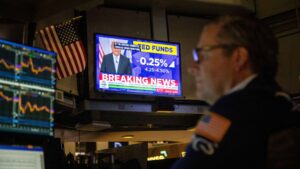Understanding the Recent Surge in Market Volatility: What Investors Need to Know
On December 18, 2024, the Federal Reserve’s announcement regarding interest rate cuts sent shockwaves through the financial markets, triggering a historic spike in Wall Street’s fear gauge, the CBOE Volatility Index, or VIX. At Extreme Investor Network, we believe that understanding these market dynamics is crucial for both novice and seasoned investors. Let’s delve into the details of this recent event and explore its implications for your investment strategy.
The Context: Federal Reserve’s Dilemma
The Federal Reserve indicated a significant change in its monetary policy, projecting only two interest rate cuts for the upcoming year—down from the four cuts anticipated just three months prior. This announcement was met with alarm from investors, who had been relying on lower interest rates to fuel a prolonged bull market. The Dow Jones Industrial Average (DJIA) responded negatively, plummeting 1,100 points, marking its tenth straight loss.
The Volatility Index (VIX): What You Should Know
The VIX operates as a barometer of market fear, calculating expected volatility based on the prices of put and call options tied to the S&P 500. When investor sentiment turns bearish, as it did following the Fed’s announcement, the demand for put options rises, driving the VIX higher.
On this particular day, the VIX surged by an eye-popping 74%, closing at 27.62. To put this into perspective, this increase ranks as the second-largest percentage spike in the index’s history, surpassed only by the explosive 115% rise during February 2018, which was triggered by a liquidity crisis affecting funds linked to volatility.
A Historical Perspective on VIX Spikes
Surges in the VIX often coincide with moments of economic uncertainty and investor anxiety. Earlier in 2024, another notable surge occurred on August 5, when the VIX soared by around 65% due to recession fears and shifts in global currency trading. On that day, the index even touched an intraday high of 65, demonstrating just how quickly investor sentiment can shift.
Historically, a VIX reading above 20 signals elevated market fear. For much of 2024, however, the VIX had remained below this threshold, leading to concerns that investors were becoming dangerously complacent—a scenario that proved to be a ticking time bomb when the Fed’s announcement finally struck.
Key Takeaways for Investors
-
Monitor Rate Predictions: Keeping a close eye on Fed statements and market forecasts can provide crucial insights into future market movements. The Fed’s changing stance on interest rates profoundly affects investor psychology and market dynamics.
-
Understand Market Indicators: Tools like the VIX can help gauge market sentiment. Sudden spikes in the VIX often precede market corrections, so understanding these signals can aid in making timely investment decisions.
-
Prepare for Potential Recovery: With the VIX now floating just above the 20 mark and down over 25% from its peak following the Fed’s announcement, there may be opportunities on the horizon as certain sectors potentially recover from the panic selling.
-
Diversification Is Key: In unpredictably volatile markets, diversification across asset classes can help mitigate risk. Consider incorporating a range of investments—stocks, bonds, alternatives—to safeguard your portfolio against sharp market movements.
- Stay Informed: Knowledge is power in investing. Follow insights from financial experts and platforms like Extreme Investor Network to keep abreast of market trends and to better understand the potential impact of economic events.
Conclusion
The December 18 market reaction serves as a stark reminder of how interconnected interest rates and market psychology are in the world of finance. As investors, staying vigilant and informed is essential for navigating these tumultuous waters. At Extreme Investor Network, we’re committed to providing you with the insights and analysis you need to make informed investment decisions amidst uncertainty. Let us guide you through the complexities of the financial markets so you can seize opportunities, even in times of volatility.

